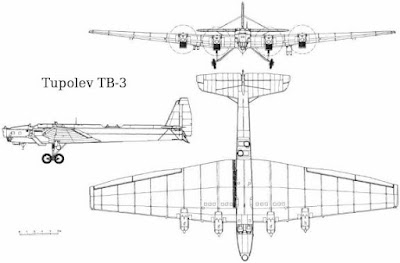The Tupolev TB-3 (ANT-6) was a long-range bomber and transport aircraft in service with the Soviet Air Force from 1932 to 1945. It was the first heavy bomber monoplane in military history. Designed by Andrei Tupolev, the prototype had performed its maiden flight in 1930. It was truly a plane ahead of its time as it was reliable and stable, being propelled by four powerful engines.
The civilian version of the Tupolev TB-3 was the ANT-6. Aside from bombing, it was also used for paratroops drops and mother ship for the Polikarpov I-16 and I-5 fighters. More than 818 aircraft was produced between 1932 and 1937. In September 1936, the Russian pilot, A Yumashev, set an international altitude record, reaching 8,116 m of altitude, with a 5-ton load. However, by the time WW2 broke out, it had already become obsolete, and during the Soviet invasion of Finland, it would be relegated to a transport role.
Technical Characteristics
The Tupolev TB-3 was a five-seat, four-engine monoplane. It features straight, cantilever, mid-wing. It was very wide at the base, with large trailing edge ailerons. It had convention tail, with one tail fin, with rudder, and one horizontal plane, with large elevators. Its landing gear was fixed.
The wing was built in five sections, with could be conveniently dismantled for rail transport. At the beginning, the TB-3 was powered by unreliable Mikulin M17 piston engines. However, they would be replaced by more powerful ones; the Mikulin M34, water-cooled, in-line, V-12 engines.
Specifications
Length: 25.10 m
Wingspan: 41.85 m
Wing Area: 234.50 square meters
Height: 5.60 m
Maximum Speed: 288 km/h
Range: 1,400 km
Armament: six machine guns; bomb-load of 5,000 kg.
Below, the Tupolev TB-3 in 1936
Drawing of the ANT-6/TB-3 prototype
Below, the TB-3 used as a paratroop transport.
A close-up view of the aircraft nose.







